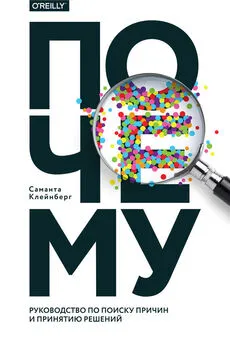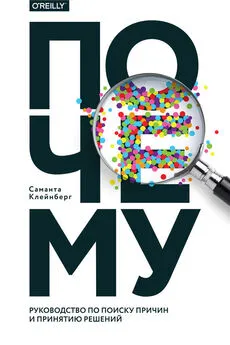Саманта Клейнберг - Почему
- Название:Почему
- Автор:
- Жанр:
- Издательство:Литагент МИФ без БК
- Год:2017
- Город:Москва
- ISBN:978-5-00100-593-3
- Рейтинг:
- Избранное:Добавить в избранное
-
Отзывы:
-
Ваша оценка:
Саманта Клейнберг - Почему краткое содержание
Книга будет интересна аналитикам, философам, исследователям, медикам, экономистам, юристам, начинающим ученым, всем, кто имеет дело с массивами данных и хочет научиться критическому мышлению.
На русском языке публикуется впервые.
Почему - читать онлайн бесплатно полную версию (весь текст целиком)
Интервал:
Закладка:
Sato, E., Furuta, R. A., and Miyazawa, T. (2010). An Endogenous Murine Leukemia Viral Genome Contaminant in a Commercial RT-PCR Kit is Amplified Using Standard Primers for XMRV. Retrovirology , 7(1): 110.
Saunders System Birmingham Co. v. Adams (1928). 217 Ala. 621, 117 So. 72.
Scheines, R. (1997). An Introduction to Causal Inference. In V. R. McKim and S. P. Turner (eds.), Causality in Crisis , pp. 185–199. University of Notre Dame Press, Notre Dame, IN.
Schlottmann, A. (1999). Seeing It Happen and Knowing How It Works: How Children Understand the Relation Between Perceptual Causality and Underlying Mechanism. Developmental Psychology , 35(5): 303–317.
Schlottmann, A., Allen, D., Linderoth, C., and Hesketh, S. (2002). Perceptual Causality in Children. Child Development , 73(6): 1656–1677.
Schlottmann, A., Ray, E. D., and Surian, L. (2012). Emerging perception of causality in action-and-reaction sequences from 4 to 6 months of age: Is it domain-specific? Journal of Experimental Child Psychology , 112(2): 208–230.
Schlottmann, A. and Shanks, D. R. (1992). Evidence for a distinction between judged and perceived causality. The Quarterly Journal of Experimental Psychology , 44(2): 321–342.
Schoenfeld, J. D. and Ioannidis, J. P. (2013). Is everything we eat associated with cancer? A systematic cookbook review. The American Journal of Clinical Nutrition , 97(1): 127–134.
Schulz, K. F. and Grimes, D. A. (2002). Blinding in randomised trials: Hiding who got what. The Lancet , 359(9307): 696–700.
Schulz, L. E., Gopnik, A., and Glymour, C. (2007). Preschool children learn about causal structure from conditional interventions. Developmental Science , 10(3): 322–332.
Schwarz, G. (1978). Estimating the Dimension of a Model. The Annals of Statistics , 6(2): 461–464.
Scriven, M. (1966). Causes, connections and conditions in history. In W. H. Dray (ed.), Philosophical Analysis and History , pp. 238–264. Harper & Row, New York.
Seok, J., Warren, H. S., Cuenca, A. G., Mindrinos, M. N., Baker, H. V., et al. (2013). Genomic responses in mouse models poorly mimic human inflammatory diseases. Proceedings of the National Academy of Sciences , 110(9): 3507–3512.
Shalizi, C. R. and Thomas, A. C. (2011). Homophily and Contagion Are Generically Confounded in Observational Social Network Studies. Sociological Methods Research , 40(2): 211–239.
Shanks, D. R. (1985). Forward and backward blocking in human contingency judgement. The Quarterly Journal of Experimental Psychology , 37(1): 1–21.
Shanks, D. R. (1995). The Psychology of Associative Learning . Cambridge University Press, Cambridge.
Shanks, D. R., Pearson, S. M., and Dickinson, A. (1989). Temporal Contiguity and the Judgement of Causality by Human Subjects. The Quarterly Journal of Experimental Psychology , 41 B(2): 139–159.
Sidhu, D. (2015). Moneyball Sentencing. Boston College Law Review , 56(2): 671–731.
Silverman, R. H., Das Gupta, J., Lombardi, V. C., Ruscetti, F. W., Pfost, M. A., Hagen, K. S., Peterson, D. L., Ruscetti, S. K., Bagni, R. K., Petrow-Sadowski, C., Gold, B., Dean, M., and Mikovits, J. (2011). Partial retraction. Science , 334(6053): 176.
Simpson, E. H. (1951). The Interpretation of Interaction in Contingency Tables. Journal of the Royal Statistical Society: Series B (Statistical Methodology) , 13(2): 238–241.
Skyrms, B. (1984). EPR: Lessons for Metaphysics. Midwest Studies in Philosophy , 9(1): 245–255.
Slobogin, C. (2012). Risk Assessment. In J. Petersilia and K. R. Reitz (eds.), Oxford Handbook of Sentencing and Corrections , pp. 196–214. Oxford University Press, New York.
Sloman, S. A. and Lagnado, D. (2015). Causality in Thought. Annual Review of Psychology , 66: 223–247.
Smith, G. C. S. and Pell, J. P. (2003). Parachute use to prevent death and major trauma related to gravitational challenge: Systematic review of randomised controlled trials. BMJ , 327(7429): 1459–1461.
Snow, J. (1854). The Cholera Near Golden Square, and at Deptford. Medical Times and Gazette , 9: 321–322.
Snow, J. (1855). On the Mode of Communication of Cholera . John Churchill, London.
Sobel, D. M. and Kirkham, N. Z. (2006). Blickets and babies: The development of causal reasoning in toddlers and infants. Developmental Psychology , 42(6): 1103–1115.
Sobel, D. M. and Kushnir, T. (2006). The importance of decision making in causal learning from interventions. Memory & Cognition , 34(2): 411–419.
Sobel, D. M., Tenenbaum, J. B., and Gopnik, A. (2004). Children’s causal inferences from indirect evidence: Backwards blocking and Bayesian reasoning in preschoolers. Cognitive Science , 28(3): 303–333.
Sober, E. (1987). Parsimony, Likelihood, and the Principle of the Common Cause. Philosophy of Science , 54(3): 465–469.
Sober, E. (2001). Venetian Sea Levels, British Bread Prices, and the Principle of the Common Cause. British Journal for the Philosophy of Science , 52(2): 331–346.
Sober, E. and Papineau, D. (1986). Causal Factors, Causal Inference, Causal Explanation. Proceedings of the Aristotelian Society, Supplementary Volumes , 60: 97–136.
Sonnenberg, L., Gelsomin, E., Levy, D. E., Riis, J., Barraclough, S., and Thorndike, A. N. (2013). A traffic light food labeling intervention increases consumer awareness of health and healthy choices at the point-of-purchase. Preventive Medicine , 57(4): 253–257.
Spanos, N. P. and Gottlieb, J. (1976). Ergotism and the Salem Village Witch Trials. Science , 194(4272): 1390–1394.
Spellman, B. A. (1996). Acting as Intuitive Scientists: Contingency Judgments Are Made while Controlling for Alternative Potential Causes. Psychological Science , 7(6): 337–342.
Spellman, B. A. and Kincannon, A. (2001). The Relation between Counterfactual (“But for”) and Causal Reasoning: Experimental Findings and Implications for Jurors’ Decisions. Law and Contemporary Problems , 64(4): 241–264.
Spencer, S. J., Steele, C. M., and Quinn, D. M. (1999). Stereotype Threat and Women’s Math Performance. Journal of Experimental Social Psychology , 35(1): 4–28.
Spirtes, P. (2005). Graphical models, causal inference, and econometric models. Journal of Economic Methodology , 12(1): 3–34.
Spirtes, P., Glymour, C., and Scheines, R. (2000). Causation, Prediction, and Search , 2nd edition. The MIT Press, Cambridge, MA. First published 1993.
Spirtes, P., Meek, C., and Richardson, T. (1995). Causal Inference in the Presence of Latent Variables and Selection Bias. In Proceedings of the Eleventh Conference on Uncertainty in Artificial Intelligence .
Starr, S. B. (2014). Evidence-Based Sentencing and the Scientific Rationalization of Discrimination. Stanford Law Review , 66: 803.
Steyvers, M., Tenenbaum, J. B., Wagenmakers, E. J., and Blum, B. (2003). Inferring causal networks from observations and interventions. Cognitive Science , 27(3): 453–489.
Stone, N. J., Robinson, J., Lichtenstein, A. H., Merz, C. N. B., Blum, C. B., Eckel, R. H., Goldberg, A. C., Gordon, D., Levy, D., Lloyd-Jones, D. M., McBride, P., Schwartz, J. S., Shero, S. T., Smith, S. C., Watson, K., and Wilson, P. W. (2013). 2013 ACC/AHA Guideline on the Treatment of Blood Cholesterol to Reduce Atherosclerotic Cardiovascular Risk in Adults: A Report of the American College of Cardiology/American Heart Association Task Force on Practice Guidelines. Journal of the American College of Cardiology , 63(25): 2889–2934.
Stoppard, T. (director). (1990). Rosencrantz & Guildenstern Are Dead [Motion picture]. Cinecom Pictures, New York.
Subbotsky, E. (2004). Magical thinking in judgments of causation: Can anomalous phenomena affect ontological causal beliefs in children and adults? British Journal of Developmental Psychology , 22(1): 123–152.
Sudman, S. and Blair, E. (1999). Sampling in the Twenty-First Century. Journal of the Academy of Marketing Science , 27(2): 269–277.
Sullivan, W. (1982). New Study Backs Thesis on Witches. The New York Times , August: p. 30.
Suppes, P. (1970). A Probabilistic Theory of Causality . North-Holland, Amsterdam.
Susser, M. (1991). What is a Cause and How Do We Know One? A Grammar for Pragmatic Epidemiology. American Journal of Epidemiology , 133(7): 635–648.
Swartz, J. J., Braxton, D., and Viera, A. J. (2011). Calorie menu labeling on quick-service restaurant menus: An updated systematic review of the literature. International Journal of Behavioral Nutrition and Physical Activity , 8(1): 135.
Takao, K. and Miyakawa, T. (2014). Genomic responses in mouse models greatly mimic human inflammatory diseases. Proceedings of the National Academy of Sciences , 112(4): 1167–1172.
Tatonetti, N. P., Denny, J. C., Murphy, S. N., Fernald, G. H., Krishnan, G., Castro, V., Yue, P., Tsau, P. S., Kohane, I., Roden, D. M., and Altman, R. B. (2011). Detecting Drug Interactions From Adverse-Event Reports: Interaction Between Paroxetine and Pravastatin Increases Blood Glucose Levels. Clinical Pharmacology & Therapeutics , 90(1): 133–142.
Thompson, W. C. and Schumann, E. L. (1987). Interpretation of statistical evidence in criminal trials: The prosecutor’s fallacy and the defense attorney’s fallacy. Law and Human Behavior , 11(3): 167–187.
Thurman, W. N. and Fisher, M. E. (1988). Chickens, Eggs, and Causality, or Which Came First? American Journal of Agricultural Economics , 70(2): 237–238.
Tulppo, M. P., Hautala, A. J., Mäkikallio, T. H., Laukkanen, R. T., Nissilä, S., Hughson, R. L., and Huikuri, H. V. (2003). Effects of aerobic training on heart rate dynamics in sedentary subjects. Journal of Applied Physiology , 95(1): 364–372.
Turner, E. H., Matthews, A. M., Linardatos, E., Tell, R. A., and Rosenthal, R. (2008). Selective Publication of Antidepressant Trials and Its Influence on Apparent Efficacy. The New England Journal of Medicine , 358(3): 252–260.
Tversky, A. and Kahneman, D. (1974). Judgment under Uncertainty: Heuristics and Biases. Science , 185(4157): 1124–1131.
Uttich, K. and Lombrozo, T. (2010). Norms inform mental state ascriptions: A rational explanation for the side-effect effect. Cognition , 116(1): 87–100.
Vandenbroucke, J. P. (2004). When are observational studies as credible as randomised trials? The Lancet , 363(9422): 1728–1731.
Vickers, A. (2010). What is a P-value anyway?: 34 stories to help you actually understand statistics . Addison-Wesley, Boston.
Vlahos, J. (2012). The Case of the Sleeping Slayer. Scientific American , 307(3): 48–53.
Waldmann, M. R. and Hagmayer, Y. (2005). Seeing Versus Doing: Two Modes of Accessing Causal Knowledge. Journal of Experimental Psychology: Learning, Memory, and Cognition , 31(2): 216–227.
Ward, A. C. (2009). The role of causal criteria in causal inferences: Bradford Hill’s “aspects of association.” Epidemiologic Perspectives & Innovations , 6(1): 2.
Watts, D. J. (2011). Everything Is Obvious: How Common Sense Fails Us . Crown Business, New York.
Waxman, O. B. (2012). Secret to Winning a Nobel Prize? Eat More Chocolate. TIME.com . Retrieved from http://healthland.time.com/2012/10/12/can-eating-chocolate-help-you-win-a-nobel-prize/.
Читать дальшеИнтервал:
Закладка:






![Саманта Даунинг - Моя дорогая жена [litres]](/books/1070823/samanta-dauning-moya-dorogaya-zhena-litres.webp)



